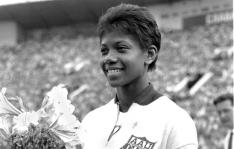
Here's a look at how women have made history, in the running world, over the past five decades.
1960
Women are allowed to participate in five running events in the Summer Olympics held in Rome--as opposed to the 16 races open to men. After being banned for 32 years due to medical concerns that the event was too taxing for the "frail" female gender, the women's 800 meters is reintroduced. Soviet Union runner Irina Press wins the race, while sister Tamara gets gold in the shot put. Western journalists dub the two women "the Press brothers."
More: 4 Historical Running Events
1961
The Amateur Athletic Union (AAU) bans women from competing officially in all U.S. road races. Nineteen-year-old runner Julia Chase enters a 6.5-mile road race in Chicopee, Massachusetts, in an attempt to challenge the ban. While her run garners media attention, her plight is largely regarded as a spectacle. New York Journal American writes: "Miss Chase said she is 5'4 ?", weighs 118 pounds and does not know her other dimensions. (Eyewitnesses report her other dimensions are very good.)"
1967
Kathrine Switzer runs the Boston Marathon with an official bib by registering under the name K.V. Switzer. Race official Jock Semple attempts to pull Switzer off the course mid-race, but is body blocked by Switzer's boyfriend. Switzer finished the race in 4:20 and is subsequently banned from the AAU.
1972
The AAU allows women to register for marathons, but they are required to start at a separate time or starting line than men. In the 1972 New York City Marathon, women refuse to subscribe to the "special" start, and sit down for 10 minutes at the starting line until the men's gun goes off.
More: 5 Secrets to Reach Your Running Goals
1977
Fed up with feeling uncomfortable while exercising, runners Lisa Lindahl, Polly Smith and Hinda Schreiber fashion a top out of two jockstraps sewn together. The sports bra--dubbed Jogbra--is born. Moving Comfort is founded the same year, and releases the first women-specific running short.
1979
Grete Waitz solidifies her soon-to-be eight-race winning streak with a second first-place finish in the New York City Marathon. Waitz crosses the line in 2:27:33, shattering her own world record, and becoming the first woman in history to finish 26.2 miles in under 2.5 hours.
1980
The American College of Sports Medicine releases a statement in support of the creation of the women's Olympic Marathon. It states, "There exists no conclusive scientific or medical evidence that long-distance running is contraindicated for the healthy, trained female athlete."
More: Marathoning Around the World
1984
After years of hard work and lobbying by passionate female and male athletes alike, the women's Olympic Marathon makes its debut in the Los Angeles Summer Olympics. American runner Joan Benoit becomes the first female gold medalist in the event. She later says of running the final leg into the Olympic stadium: "Once I passed through that tunnel, I knew things would never be the same."
1986
Mother runners everywhere cheer the first jogging stroller made for two children when Baby Jogger, a company developed two years prior by a dad who wanted more time to spend with his infant son, releases The Twinner.
- 1
- of
- 2
About the Author











Discuss This Article